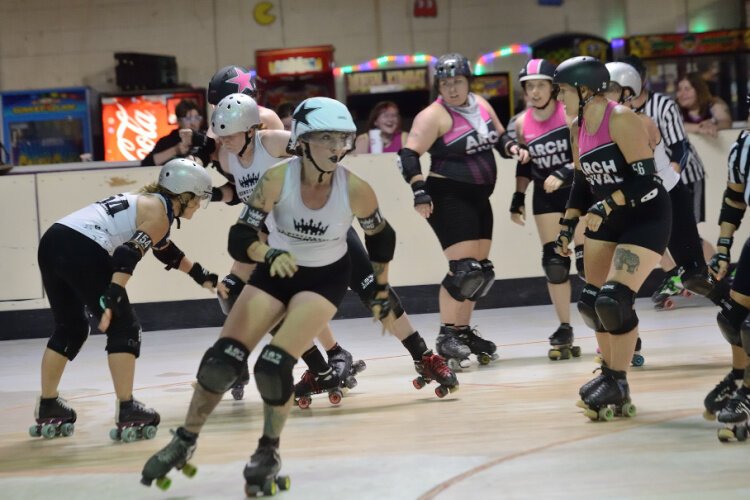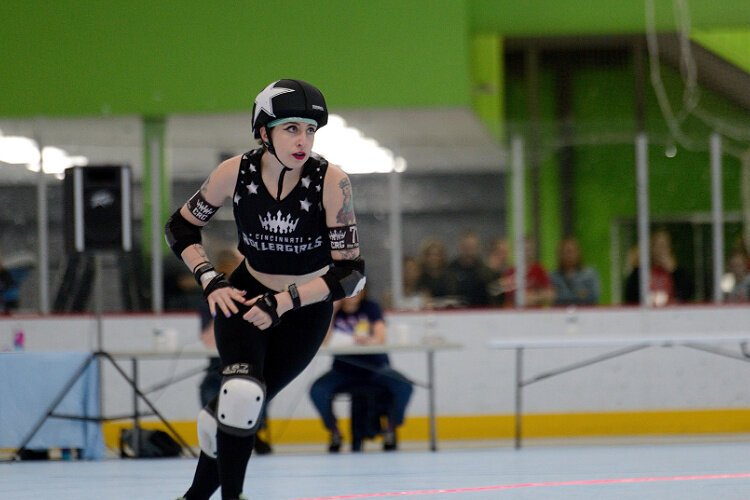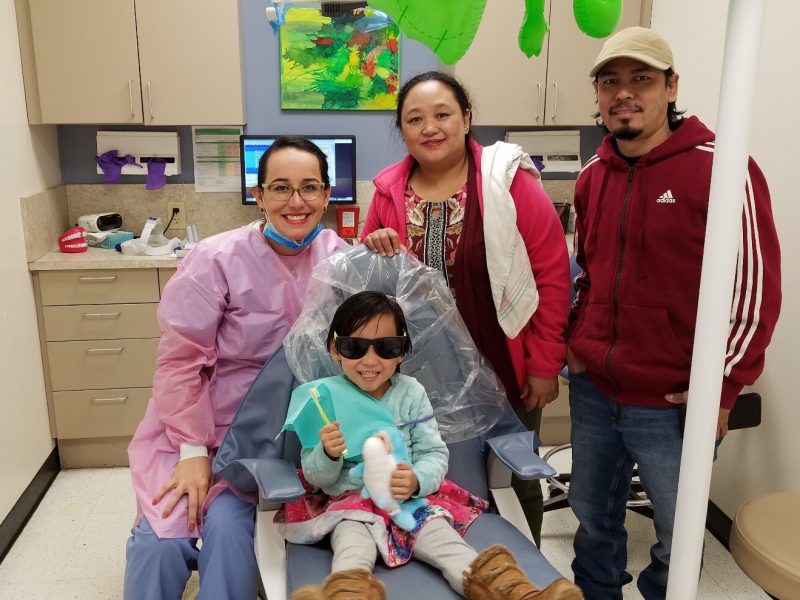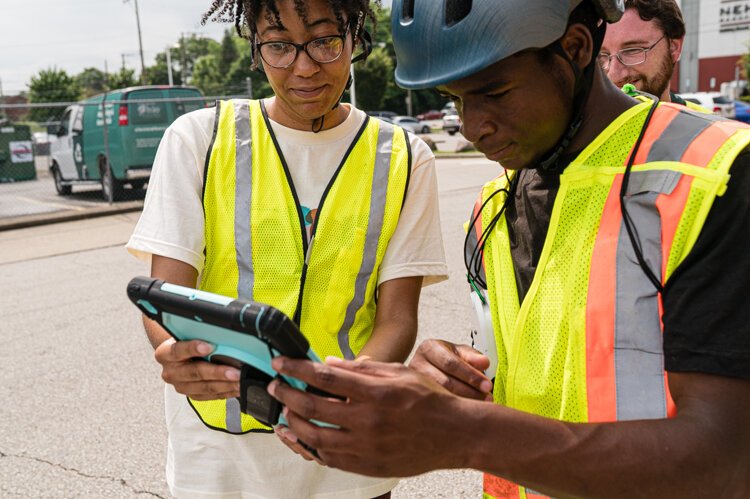Cincinnati Rollergirls want you to come out and play
The modern roller derby vibe of strong-minded women doing their own thing their own way is a perfect fit for Cincinnati. It's about fun, fortitude, feistiness, friendship and female empowerment.
Junie B. Bones. Chile con Carnage. Francis Von Deathenstein. Pain Austen. Ursa Maimer. Krystonite. No, these aren’t the names of contenders on the 1990s-era hit show Gladiators (or the recent Gladiators reboot on the BBC). They’re some of the skaters on the Cincinnati Rollergirls (CRG) 2024-25 team roster.
While the names are playful and the amateur athletes on the Black Sheep team skate for the love of the sport rather than a lucrative paycheck, these ladies are serious about roller derby. The team practices twice each week, explains Sam Fox, AKA Star Flatten’em, who pulls double-duty as the team’s public relations director and a “jammer” whose goal in the rink is to get in as many laps as possible before the buzzer sounds.
“Sunday practices are two and a half hours long, with the first half consisting of drills and practicing game-play strategy and the second half consisting of a scrimmage where the team is divided in half and we all just play roller derby against each other while incorporating the things covered in the practice,” Fox explains.
In addition, the team has shorter practices on Tuesday nights. “Off the track, skaters often do extra work to keep themselves in derby shape – we’ve had skaters who powerlift, climb and run. We even have a member who also plays for a women’s football league here in Cincinnati!” says Fox.
Given this mix of character-driven drama and athleticism, you can start to get a feel for the sport in general. Another player, Krysten Lapid, AKA Krystonite, is a “blocker” on the team whose job is to make it as tough as possible for jammers to roll past. “I wear game day face paint, and I feel like it makes me look more intimidating. Especially when I’m one-on-one with the jammers,” says Lapid. “I love just being in the way.”
The Black Sheep and Violent Lambs
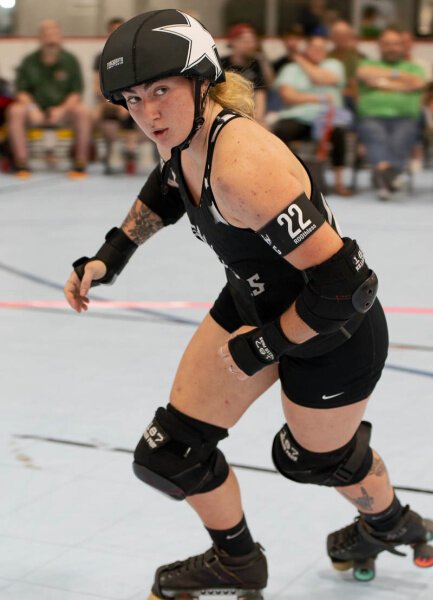
The Cincinnati Rollergirls are one of about 270 women’s roller derby teams in the US, and 435 teams worldwide. Technically, there are two Cincinnati Rollergirls teams, the Black Sheep A Team and the Violent Lambs B team. Currently, they’re only running one team, the Black Sheep, but expect to get the Violent Lambs up and rolling again soon.
Here’s how it works:
In general, the roller derby community is extremely inclusive and welcoming. Anyone who is interested in playing can give the sport a spin. The team will gladly include beginners in its weekly practices, starting out the wobbly-wheeled with a focus on learning and gaining skating stability. Next, skaters can graduate to the Nati Lights. “They’re just about there,” says Fox, “more stable, more skilled, they have the skating fundamentals but are still learning how to handle contact and the strategy of the game.”
From there, the skaters get called up to the big leagues to compete in games as part of the Black Sheep team. “We currently have about 25 skaters across all of our skill levels, some of whom are working their way toward being roster-ready,” explains Fox. “So, we’re very optimistic about being able to start bringing back our Violent Lambs very soon.”
Come and see the action for yourself — and bring the kids!
Most games take place at Queen City Sportsplex (formerly Sports Plus) in Evendale, an indoor rink that seats over 300 spectators. “We often sell out at the Sportsplex,” shares Fox. “They’ve increased our capacity twice!” They also play at the Cintas Center at Xavier University, with capacity for 1,000. Fun fact: At Cintas, the CRG skate on the concrete surface that lies beneath the shining, polished basketball arena.
Tickets can be purchased online about four to six weeks before each game. The games are family-friendly and affordable, with tickets priced at $7 for kids 13 and under, and $15 for adults. CRG aim for family fun, not only encouraging kids to come and watch, but also involving them in halftime events, like contests kids can participate in, plus mascot and character meet-and-greets. Also watch out for themed nights, like Superhero and Star Wars nights. One recent half-time show even featured skaters in drag.
Now accepting new recruits…
There’s another reason the Rollergirls want you to come out and watch — fascinated fans often feed their rosters. “People get involved in the team because they come to a game and see how fun it is, and realize it’s an all-volunteer league, and they’re like I want to do that too!” says Fox.
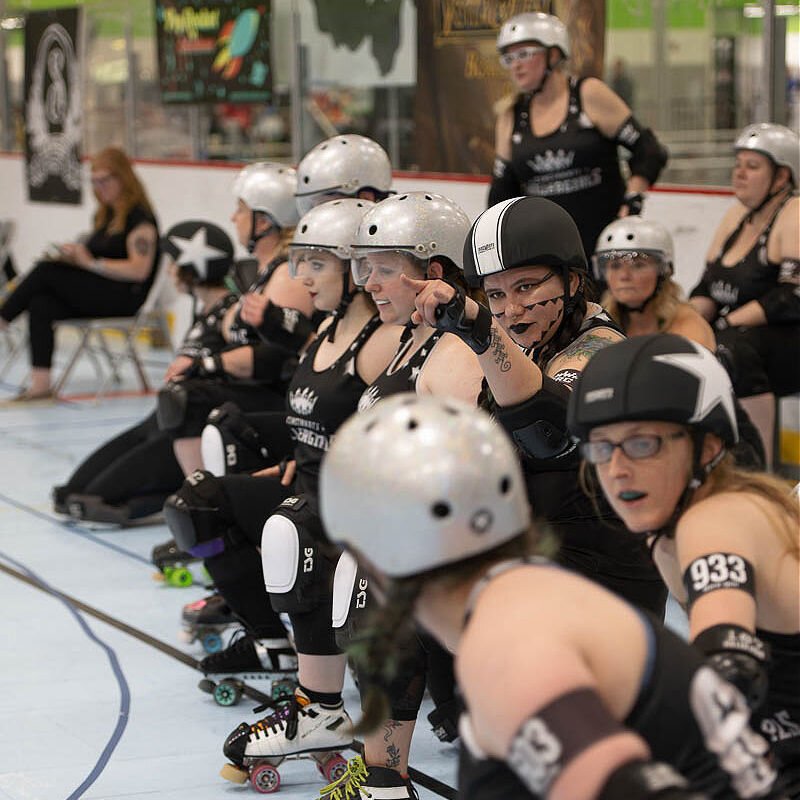
Since the team’s formation in 2005, the CRG has been steadily growing and is now rolling toward its twentieth anniversary next year. They’re drawing teams to compete in Cincinnati from across the region, and even further afield. In 2024, Vett City from Bowling Green, KY; Terrorz from Columbus, IN; Kalamzoo from its eponymous hometown in MI; and Roller Derby of Central KY, from Lexington, will make the trip to compete on the CRG home turf.
The CRG reciprocates by traveling to away games in these cities, and also in St. Louis and even as far as Denver some years. In addition to playing with the CRG, many skaters roll fluidly to so-called borderless teams. “Essentially, these teams include members who aren’t necessarily connected geographically, such as Black Diaspora Roller Derby, Team Indigenous Rising and Trans Rollers United. The communities have a lot of overlap as well; we have quite a few skaters who have offered to fill spots on rosters and have visited other teams to play in scrimmages and games just for fun,” explains Fox.
This community-minded, inclusive practice is a hallmark of the sport’s evolution over the last decade or so. At the start, roller derby could be a bit “cliquish,” with teams often staying in their own little bubbles, recalls Fox. “Now there’s a lot more community crossover. People are interested in pickup games, and during the off-season about once a month, there’ll be one big open scrimmage where pretty much anyone can come in and play,” she says.
For example, Lapid now plays on Team Philippines. “I’m half-Filipino, and I was so excited when I found a Philippines roller derby team. I got to play with them this past February at a tournament called Y’all Stars,” she recalls. Her initial worry about getting to know her new teammates quickly faded – and it seems that’s just how it is in the roller derby community. Whether scrimmaging with local teams or playing in other states such as Michigan or Colorado, players quickly find themselves among friends.
“At each game/scrimmage, I’m always meeting new people and making more friends and connections,” says Lapid. “I know if I go somewhere new to play, I will always leave with a new friend.”
A quick history of roller derby
While the modern iteration of roller derby played today has been around for a little over 20 years, it’s been in motion in some form or other for nearly a century. The sport has its roots in the 1930s when it was run as skating marathons. Soon a promoter discovered that players pushing and shoving for position swelled spectator attendance at events. After a revival in the 1970s when the sport was often televised on Saturday afternoons, it was largely quiet on the roller derby front until a group of Austin, TX women revived it as an all-female sport with plenty of drama and bravado for good measure.
Home grown in the Queen City
Turns out, the modern roller derby vibe of strong-minded women doing their own thing their own way is a perfect fit for Cincinnati. Today, it’s about fun, fortitude, feistiness, friendship and female empowerment.
“We bring such a unique sporting experience and an inclusive environment to Cincinnati,” says Fox. “What we do overlaps with so many different aspects of the community – I love using the term ‘cultural fabric,’ because it feels like CRG has woven itself into the greater Cincinnati community,” she says.
It’s just the right amount of quirky in a city where you often find the most interesting bits hidden just below a seemingly strait-laced façade.

